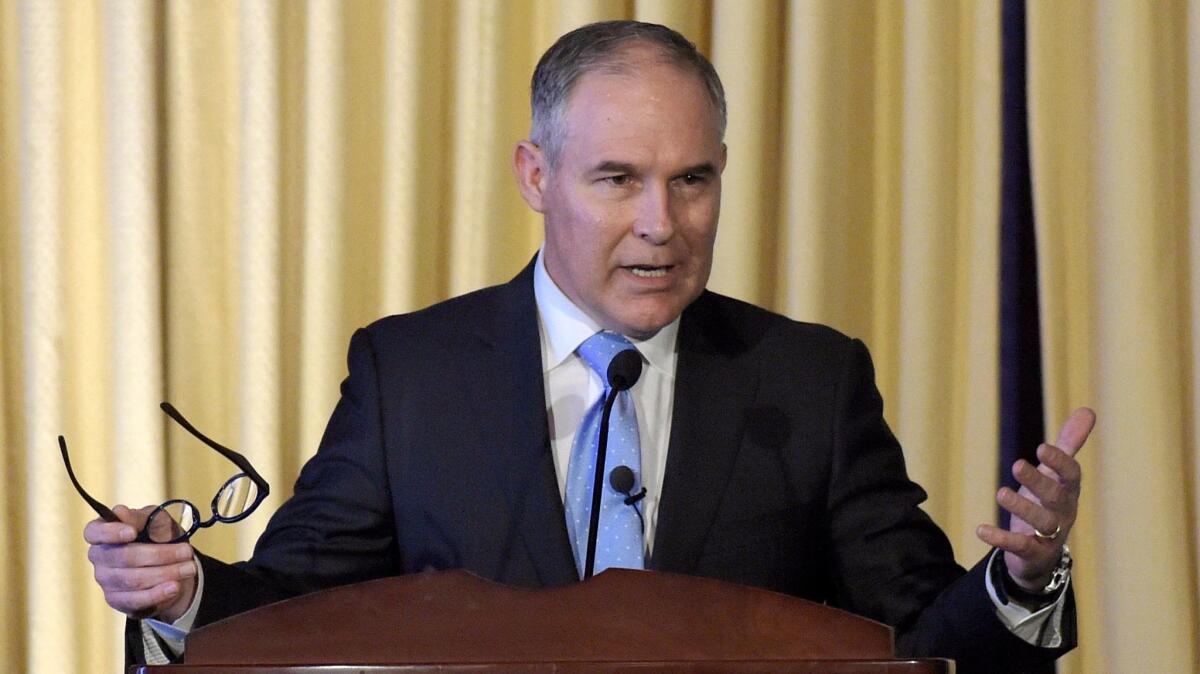There’s fear that the EPA’s request for a court delay may lead to dirtier air

When the U.S. Environmental Protection Agency adopted a stricter smog limit in 2015, forcing states to reduce emissions, many people were disappointed.
At the time, the agency reduced the ground-level ozone standard to 70 parts per billion, down from the 75-ppb standard adopted in 2008 under the George W. Bush administration.
Industry groups and some states criticized the standard as too strict, arguing it would hinder economic growth, while public health advocates and environmentalists, who had called for a 60-ppb standard, argued the rule wasn’t protective enough.
Groups from both sides sued the EPA, which was set this month to defend the 2015 rule in court.
In light of President Trump’s pro-growth agenda, EPA continues to carefully review the broad implications of the 2015 ozone standard.
— EPA spokeswoman Liz Bowman
But now, at the request of the EPA, the case is on hold — and environmentalists fear the Trump administration will ditch the cleaner standard.
A federal appeals court panel this week agreed to suspend the case to give the EPA time to review, and possibly reconsider, the standard.
“In light of President Trump’s pro-growth agenda, EPA continues to carefully review the broad implications of the 2015 ozone standard and ensure that we are supporting American jobs and protecting human health and the environment,” EPA spokeswoman Liz Bowman said via email.
Environmental and health groups filed court papers opposing the delay. They worried that the move may signal plans by the EPA to weaken the standard or delay its implementation.
“What’s at stake here is clean air,” said Seth Johnson, an attorney with Earthjustice, which filed court papers opposing the agency’s request. “The Environmental Protection Agency is supposed to make sure that the air gets cleaned up, and if they do put a pause on implementing the standard, the air is going to stay dirtier for longer.”
Ozone is formed when pollution from cars, trucks, power plants and refineries cooks in the heat and sunlight. Exposure can trigger asthma attacks and other breathing problems. Johnson said any delay could lead to unnecessary deaths.
The new rule was expected to have the largest effect in California, which has some of the worst air quality in the nation and has in the past failed to meet smog standards. On 132 days last year, the ozone level in much of the greater Los Angeles area failed to meet the standard. Most of the violations occurred during summer months.
“L.A. has the worst ozone pollution in the country,” said Adrian Martinez, another Earthjustice attorney. “We need the federal government setting stringent standards so California can protect us from dangerous smog.”

It’s not yet clear what changes, if any, the agency plans to make, but experts say it’s safe to assume the standard won’t get more strict. At the head of the agency now is Scott Pruitt, the former Oklahoma attorney general, who was part of a group that sued the EPA over the smog standard, arguing it was too restrictive.
“It definitely calls the possibility of loosening the requirement, which would allow there to be a higher level of ozone” than the current rule allows, said Jim Rubin, an environmental attorney.
The appeals court ordered the EPA to file status reports every 90 days on the agency’s review of the 2015 rule.
The agency was scheduled in October to issue findings on which regions failed to meet the standard, Rubin said, though it’s unclear whether — and when — the agency will move forward with those findings.
“It’s unlikely the agency will put time and effort into implementing a standard it’s still questioning,” Rubin said.
Dave Clegern, a spokesman for the California Air Resources Board, called the agency’s review “unnecessary” and said loosening the standard would be a mistake.
“We signed off on those standards too. We believe they are based in sound science and they are necessary for public health,” Clegern said. “They already have done all the science involved in this…. Whatever review they run, if they’re running it scientifically, they will get the same results as they have now.”
alene.tchekmedyian@latimes.com
Follow me on Twitter @AleneTchek
More to Read
Start your day right
Sign up for Essential California for news, features and recommendations from the L.A. Times and beyond in your inbox six days a week.
You may occasionally receive promotional content from the Los Angeles Times.







